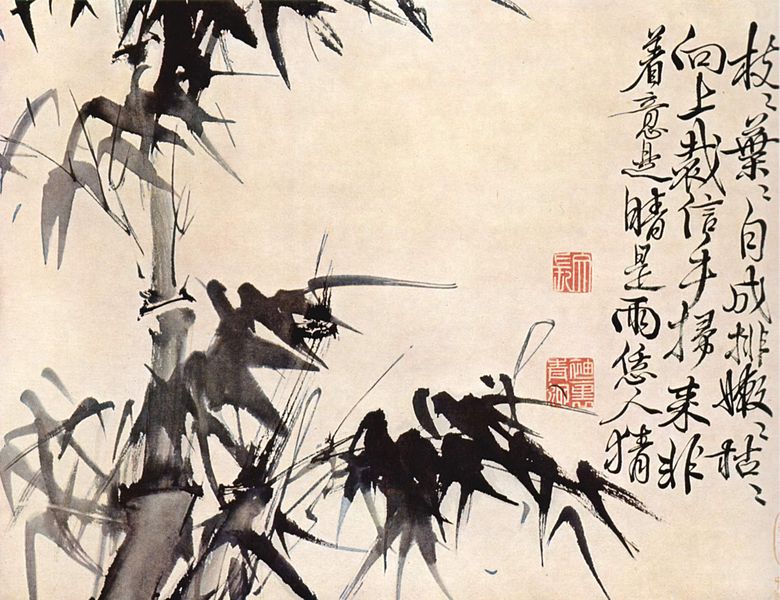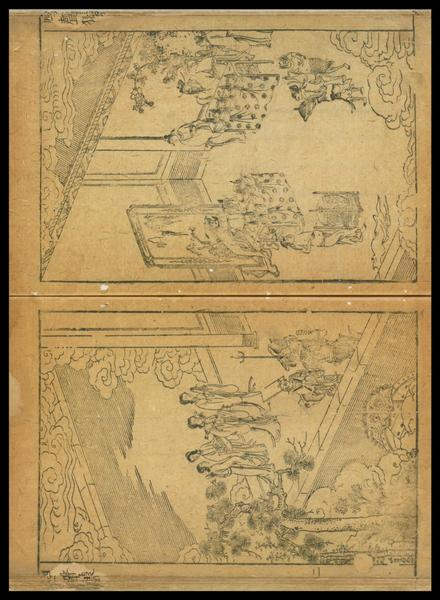 1
1title: Bambus
artist: xu wei
date: 1540-1590
medium: de 1=Tusche auf Papier
dimensions: de 1=32,5 cm hoch
current location: de|1=Freer Gallery of Art de|1=Washington (D.C.)
source: Yorck
credit: The Yorck Project () 10.000 Meisterwerke der Malerei (DVD-ROM), distributed by DIRECTMEDIA Publishing GmbH. ISBN: 3936122202.
license:Public domain
 2
2title: Chrysanthemums and Bamboos
artist: xu wei
date: 16th century
current location: :museum:Liaoning Provincial Museum
source: link
credit: link
license:Public domain
 3
3title: Xu Wei, Chinese Sixteen Flowers - Google Art Project
artist: xu wei, Chinese, 1521 - 1593 (1521 - 1593) – Artist/Maker (Chinese) Born in China.Details of artist on Google Art Project
date: 16th century; Ming Dynasty (1368-1644)
medium: en Ink on paper; mounted as a hanging scroll
dimensions: w991 x h3329 in
current location: Philadelphia Museum of Art
credit: RQGh3JGYNAdN9g at Google Cultural Institute maximum zoom level
license:Public domain
 4
4title: The Four Cries of the Gibbon
artist: xu, wei, 1521-1593
date: between 1567 and 1644
medium: ru 1=Книги fr 1=Livres en 1=Books zh 1=图书 pt 1=Livros ar 1=كتب es 1=Libros
dimensions: en 1=4 juan, 2 volumes : illustrations ;20.6 x 14.5 centimeters
current location: ru|1=Национальная центральная библиотека fr|1=Bibliothèque centrale nationale en|1=National Central Library zh|1=国立中央图书馆 pt|1=Biblioteca Nacional Central ar|1=المكتبة المركزية الوطنية es|1=Biblioteca Nacional Central
description: This drama is by xu wei (1521–93), a literary writer, painter-calligrapher, and playwright. A native of Shanyin, Zhejiang, xu wei used various pseudonyms, among them Qingteng Jushi (Resident of the Green Vine House). Despite his talents and early achievements in painting, poetry, and essay writing, he failed in eight attempts to pass the civil examinations and never achieved a jin shi degree. He served under General Hu Zongxian, the supreme commander of the Jiangsu–Zhejiang–Fujian coastal defense against the Japanese pirates, but lost his post after the general was arrested and removed from his position. xu became mentally distraught and attempted to commit suicide many times. He went insane, killed his wife, and was imprisoned. After his release, he remained impoverished and depressed until his death. His painting, revolutionary for its time with an expressive style and unrestrained broad brushstrokes, influenced countless painters of later generations. He also left behind a number of excellent dramas. This work is a composite poetic drama formed from his four plays: Kuang gu shi Yuyang san long (The history of the mad drummer of Yuyang), Yu chan shi Cuixiang yi meng (A zen master’s dream of the land of green jade), Ci Mulan ti fu cong jun (The heroine Mulan goes to war in her father’s place), and Nü zhuang yuan ci huang de feng (The female top graduate gives up a phoenix-hen and obtains a phoenix-rooster). Si sheng yuan (The four cries of the gibbon), probably was derived from a folk ballad in Badong Sanxia (The Three Gorges in Badong), which describes the three cries of the monkey that reduced people to tears. The story, taken from chapter 23 of San guo yan yi (Romance of the Three Kingdoms), tells of Mi Heng (173–98), a talented scholar, who has served his term in the nether world after his death and is about to ascend to the heavens to assume a new position. Before he does so, he is asked by a judge to reenact his encounter with Cao Cao (155–220), chancellor of the Eastern Han dynasty and later head of the state of wei, who is also in the nether world. Mi Heng then tells how he was unwilling to serve Cao and behaved disrespectfully toward him, so that Cao made him a drum master at the imperial court in an attempt to humiliate him. Dressed in shabby clothes, Mi stripped naked, and played the tune of a poignant song on the drum, bringing tears to the guests’ eyes. Mi reenacts this scene and reviles Cao, listing all Cao’s treacheries. Preceding each scene of the play is a woodblock illustration with an inscription. Mi Heng is depicted naked while beating the drum. Cao Cao is shown in the upper portion of the picture, observing from his high position, with a ghostly guard on each side. The characters are delicately depicted in the illustrations.
Chinese classics; Chinese dramalicense:Public domain
 5
5title: Chinese woodcut; Abscesses - 'Lotus Seed' abscess Wellcome L0038770
artist: unknown
source: link * Gallery: link * Wellcome Collection gallery (2018-03-28): link [link CC-BY-4.0]
credit: link Gallery: link Wellcome Collection gallery (2018-03-28): link CC-BY-4.0
description:
Woodcut illustrating the 17th century textXu Ping waike zhengzong(Orthodox Manual of External Medicine with Commentary by xu Dachun), from an edition published in 1860 (10th year of the Xianfeng reign period of the Qing dynasty). Lotus seed abscess (lianzi fa ju) refers to a type of abscess shaped like a lotus seed, with a prominent head, which is found on the shoulders or back. If the lesions are raised, red and inflamed and suppurating, the prognosis is favourable; if, however, they are depressed or concave, meaning that this is a Yin condition, the prognosis is unfavourable. The renowned Qing physician xu Dachun writes in his commentary that, all toxic lesions being 'many-headed' (duotou), the preferred method of treatment is that of 'encircling medication' (weiyao), whereby the medication is applied all around the perimeter of the lesion, omitting the head. This is an external treatment.
Wellcome Images
Keywords: Abscess; Medicine, Chinese Traditional; Ulcerlicense:
CC BY 4.0
 6
6title: Peony
artist: xu wei
date: 16th century
medium: Technique 1=hanging scroll adj= and=ink adjand= and2= on=paper adjon= over= adjover= mounted= adjmounted=
dimensions: Size cm 133.3 34.5
current location: Institution:National Palace Museum
source: link
credit: link
license:Public domain
 7
7title: 明 傳徐渭 校靜菴文有感詩 軸 Poem Composed after Editing Jingan's Literary Works MET 1989 363 91 O.
artist: Follower of xu wei
date: dated 1576
medium: Hanging scroll; ink on silk
dimensions: Image: 54 3/8 x 19 in. (138.1 x 48.3 cm) Overall: 87 1/4 x 26 1/4 in. (221.6 x 66.7 cm) Overall with knobs: 87 1/4 x 28 1/2 in. (221.6 x 72.4 cm)
current location: Institution:Metropolitan Museum of Art
source: link Template:TheMet
credit: This file was donated to Wikimedia Commons as part of a project by the Metropolitan Museum of Art. See the Image and Data Resources Open Access Policy
license:
CC0
 8
8title: 明 傳徐渭 校靜菴文有感詩 軸 Poem Composed after Editing Jingan's Literary Works MET 1989 363 91 mtg.
artist: Follower of xu wei
date: dated 1576
medium: Hanging scroll; ink on silk
dimensions: Image: 54 3/8 x 19 in. (138.1 x 48.3 cm) Overall: 87 1/4 x 26 1/4 in. (221.6 x 66.7 cm) Overall with knobs: 87 1/4 x 28 1/2 in. (221.6 x 72.4 cm)
current location: Institution:Metropolitan Museum of Art
source: link Template:TheMet
credit: This file was donated to Wikimedia Commons as part of a project by the Metropolitan Museum of Art. See the Image and Data Resources Open Access Policy
license:
CC0
 9
9title: MET CP46
artist: xu wei
medium: Polychrome woodblock print; ink and color on paper
dimensions: 9 5/8 x 11 13/16 in. (24.4 x 30 cm)
current location: Institution:Metropolitan Museum of Art
source: link Template:TheMet
credit: This file was donated to Wikimedia Commons as part of a project by the Metropolitan Museum of Art. See the Image and Data Resources Open Access Policy
license:
CC0

title: Consort Zhen at her Morning Toilette
artist: Hua xu (active c. 1799)
medium: Hanging scroll; ink and colors on silk
dimensions: 61.6 × 37.1 cm
current location: Institution:Shanghai Museum
source: [link Consort Zhen at her Morning Toilette]. ''[link Telling Images of China]'' (2010 exhibit). Dublin: Chester Beatty Library.
[link (direct link to image)]
[link (web archive link for work)]
[link (web archive link for exhibit)]credit: Consort Zhen at her Morning Toilette. Telling Images of China (2010 exhibit). Dublin: Chester Beatty Library.
(direct link to image)
(web archive link for work)
(web archive link for exhibit)license:Public domain





